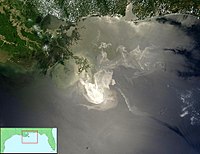
Photo from wikipedia
Abstract Optical identification and quantification of various marine-spilled oils play an important role in oil spill monitoring, assessment, and response. Through weathering processes, oil may become emulsified in two forms… Click to show full abstract
Abstract Optical identification and quantification of various marine-spilled oils play an important role in oil spill monitoring, assessment, and response. Through weathering processes, oil may become emulsified in two forms of oil-water mixture: water in oil (WO) and oil in water (OW). These two forms of oil emulsion are significantly different in their volume concentration (oil/water ratio), physical properties (viscosity, density, thickness), and optical properties (spectral reflectance (Ru(λ), sr−1), and spectral absorption (a(λ), m−1)). In this study, the optical properties of both types of oil emulsion, with different volumetric concentrations, are determined from carefully prepared oil emulsion samples, with the aim of helping to interpret optical remote sensing imagery. The concentrations of stable WO and OW emulsions range from 45% to 95% and from 0.025% to 3%, respectively. They exhibit different Ru spectral shapes in the near-infrared and shortwave-infrared wavelengths, with five “-CH” molecular bonds evident in the WO emulsion spectra. Ru (600–1400 nm) of OW emulsions increases with volume concentrations from 0% to 3.0%, but Ru (600–2400 nm) of the WO emulsions decreases with volume concentrations from 45% to 100%. On the other hand, for a fixed concentration (80%), Ru (600–2400 nm) of WO emulsions increases monotonically with thicknesses of up to ~0.4 mm, beyond which Ru (600–2400 nm) no longer increases with oil thickness. The difference between the Ru spectral shapes of OW and WO emulsions, as well as the statistical relationships between volume concentrations and Ru (NIR-SWIR) and between oil thickness and Ru (NIR-SWIR), provide the basis for developing optical models to classify oil emulsion types and for quantifying oil volume from remote sensing imagery. The potential of such an application is demonstrated using hyperspectral AVIRIS imagery collected over the Deepwater Horizon (DWH) oil spill in the Gulf of Mexico (GoM).
Journal Title: Remote Sensing of Environment
Year Published: 2019
Link to full text (if available)
Share on Social Media: Sign Up to like & get
recommendations!